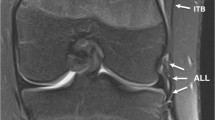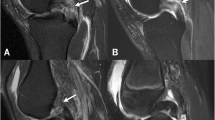Abstract
Objectives
Our objectives were to determine retrospectively the prevalence, patients’ demographics, mechanism of injury, combination of torn ligaments, associated intra-articular and extra-articular injuries, fractures, bone bruises, femoral–tibial alignment and neurovascular complications of knee dislocations as evaluated by magnetic resonance (MR) imaging.
Materials and methods
From 17,698 consecutive knee examinations by magnetic resonance imaging (MRI) over a 6-year period, 20 patients with knee dislocations were identified. The medical records of these patients were subsequently reviewed for relevant clinical history, management and operative findings.
Results
The prevalence of knee dislocations was 0.11% [95% confidence interval (95% CI) 0.06–0.16)]. There were 16 male patients and four female patients, with ages ranging from 15 years to 76 years (mean 31 years). Fifteen patients had low-velocity injuries (75%), of which 11 were amateur sports related and four were from falls. Four patients (20%) had suffered high-velocity trauma (motor vehicle accidents). One patient had no history available. Anatomic alignment was present at imaging in 16 patients (80%). Eighteen patients had three-ligament tears, two had four-ligament tears. The four-ligament tears occurred with low-velocity injuries. The anterior cruciate ligament (ACL) and posterior cruciate ligament (PCL) were torn in every patient; the lateral collateral ligament (LCL) was torn in 50%, and the medial collateral ligament (MCL) in 60%. Intra-articular injuries included meniscal tears (five in four patients), fractures (eight in seven patients), bone bruises (15 patients), and patellar retinaculum tears (eight partial, two complete). The most common extra-articular injury was a complete biceps femoris tendon tear (five, 25%). There were two popliteal tendon tears and one iliotibial band tear. One patient had received a vascular injury following a motor vehicle accident (MVA) and had been treated prior to undergoing MRI. Bone bruises (unrelated to fractures), four-ligament tears, biceps femoris tears, and popliteus tendon tears were encountered only in the low-velocity knee dislocations. Twelve were treated surgically, five conservatively, and three had been lost to follow-up. The biceps femoris tendon was repaired in every patient who was treated surgically.
Conclusions
Knee dislocations occurred more commonly in low-velocity injuries than in high-velocity injuries, predominantly affecting amateur athletes. Biceps femoris tendon tears were the most common extra-articular injury requiring surgery. Neurovascular injury (5%) was uncommon. At imaging, femoral–tibial alignment was anatomic in the majority of patients.





Similar content being viewed by others
References
Brautigan B, Johnson DL. The epidemiology of knee dislocations. Clin Sports Med 2000; 19: 387–397.
Green NE, Allen BL. Vascular injuries associated with dislocation of the knee. J Bone Joint Surg Am 1997; 59: 236–239.
Hoover NW. Injuries of the popliteal artery associated with fractures and dislocations. Surg Clin North Am 1961; 41: 1099–1112.
Kennedy JC. Complete dislocation of the knee joint. J Bone Joint Surg Am 1963; 45: 889–904.
Rihn JA, Cha PS, Groff YJ, Harner CD. The acutely dislocated knee: evaluation and management. J Am Acad Orthop Surg 2004; 12: 334–346.
Henrichs A. A review of knee dislocations. J Athl Train 2004;39:365–369.
Schenck RC Jr. The dislocated knee. Instr Course Lect 1994; 43: 127–136.
Schenck RC Jr, Hunter RE, Ostrum RF, Perry CR. Knee dislocations. Instr Course Lect 1999; 48: 515–522.
Twaddle BC, Hunter JC, Chapman RJ, Simonian PT, Escobedo EM. MRI in acute knee dislocation. A prospective study of clinical, MRI, and surgical findings. J Bone Joint Surg Br 1996; 78: 573–579.
Yu JS, Goodwin D, Salonen D, et al. Complete dislocation of the knee: spectrum of associated soft-tissue injuries depicted by MR imaging. AJR Am J Roentgenol 1995; 164: 135–139.
Twaddle BC, Bidwell TA, Chapman JR. Knee dislocations: where are the lesions? A prospective evaluation of surgical findings in 63 cases. J Orthop Trauma 2003; 17: 198–202.
Hollis JD, Daley BJ. 10-year review of knee dislocations: is arteriography always necessary? J Trauma 2005; 59: 672–676.
Shelbourne KD, Haro MS, Gray T. Knee dislocation with lateral side injury: results of an en masse surgical repair technique of the lateral side. Am J Sports Med 2007; 35: 1105–1116.
Shelbourne KD, Carr DR. Combined anterior and posterior cruciate and medial collateral ligament injury: nonsurgical and delayed surgical treatment. Instr Course Lect 2003; 52: 413–418.
Author information
Authors and Affiliations
Corresponding author
Rights and permissions
About this article
Cite this article
Bui, K.L., Ilaslan, H., Parker, R.D. et al. Knee dislocations: a magnetic resonance imaging study correlated with clinical and operative findings. Skeletal Radiol 37, 653–661 (2008). https://doi.org/10.1007/s00256-008-0490-z
Received:
Accepted:
Published:
Issue Date:
DOI: https://doi.org/10.1007/s00256-008-0490-z




